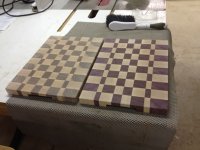Like the title says, Recommended 10" table saw blade for ripping maple?
I just picked up approximately 1,400 board feet of aged Michigan maple originally
Milled in 1966. I don't mind paying for quality, just need something that might make
It through this project.
Thanks, Mike
I just picked up approximately 1,400 board feet of aged Michigan maple originally
Milled in 1966. I don't mind paying for quality, just need something that might make
It through this project.
Thanks, Mike


